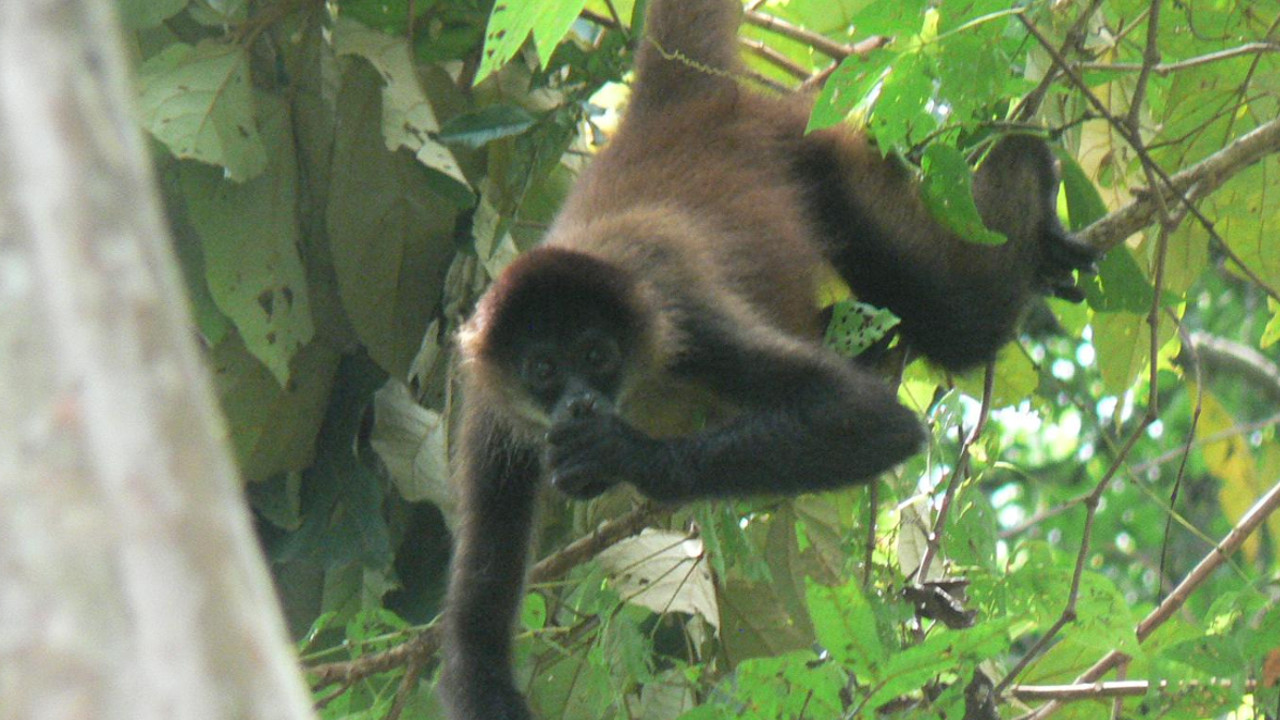In a rainy, swampy rainforest in northeastern Costa Rica, female Geoffroy’s spider monkeys (Ateles geoffroyi) go about their daily lives, blissfully unaware that they’re what humans call “an endangered species.” For them life consists of traveling through the forest, foraging on ripe fruit, caring for their offspring, and avoiding aggressive males.
The reason they can enjoy this relative peace is because they’re lucky enough to live on the protected land of a biological field station. The station was set up when landowner Hiner Ramirez’s daughters learned about the urgent need to conserve rainforest and encouraged their father to convert the family’s land — which he used to harvest trees for shipping pallets — into a protected reserve. He approached professors who were teaching at a nearby field station and made plans to set up a similar research and teaching facility.
The reserve is still owned by the Ramirez family and includes 1,000 hectares (about four square miles) of primary forest, secondary forest and a mosaic of pasture land and plantation. Stands of exotic beechwood (Gmelina arborea) continued to be harvested, but the native trees that were originally planted for harvesting were left to regenerate, and the former plantation areas have been made available to the wildlife.
Over multiple field seasons I spent there from 2005-2011, the shy female monkeys with infants became accustomed to my presence. I grew to love crawling in the swamps (which I frequently fell into), and racked up an impressive number of painful bites from inch-long bullet ants. My colleagues and I also discovered many unique behaviors in these monkeys. We observed several individuals using sticks to scratch themselves, a behavior that hasn’t been seen at other sites. We saw some other surprising behaviors, too, such as crossing forest gaps and sitting on the ground, an unusual behavior for an arboreal species. We even witnessed a couple of one-armed juveniles, that managed to travel gracefully despite their handicap. We aren’t sure whether these lost limbs are due to birth defects or injuries, but we continue to investigate potential causes and consequences.
Scientists studying spider monkeys across Central and South America originally thought the animals could only live in pristine primary, untouched forest, but the animals at the field station appeared to be doing well despite the fragmented habitat. Still, the behaviors we observed did not answer the biggest question: How were these spider monkeys in the secondary forest truly coping with their environment? Were they healthy, or were there any unhealthy conditions we could not see from mere observation? Spider monkeys are picky eaters that depend on ripe fruits, so they travel over large distances and monitor trees to find fruit that’s ripened to their liking. This makes them extremely sensitive to environmental disturbances. Female spider monkeys are particularly vulnerable due to the energy costs of seven-month pregnancies and then nursing infants for another two to three years.
To try to better understand how this affected the population, I studied behavior and stress hormones from fecal samples in 17 monkeys from 2010 to 2011 to determine if changes in fruit availability either altered their behavior or created elevated stress levels.
Contrary to my predictions, the spider monkeys did not exhibit elevated stress hormones in response to low fruit availability. Instead, I observed, they ranged in small groups when fruit was scarce and increased their subgroup size when fruit was plentiful. This flexible social system, in which a larger community splits off into variable subgroups, allowed them to strategically cope with variation in food availability without getting stressed. However, females that had the lowest resting times had the highest stress levels, and resting time predicted high stress hormones.
My results, published this week in the International Journal of Primatology, suggest that spider monkeys can use adaptive social strategies to help them cope with living in disturbed habitats, an important element in our understanding of this species.
It’s not just social behavior, though. This habitat also offers some tasty food options that counteract the negative effects of disturbance. My observations indicate that their top food resource was Pílon (Hyeronima alchorneoides), which was first planted as harvestable tree stands but had since been left to grow and sustain wildlife. Additionally, I occasionally caught them raiding the station garden for both bananas and guava. In fact, bananas foraged from the abandoned plantation turned out to be one of their top five food resources. The availability of these foods, as well as the large size of the preserve and protected status, allow them to thrive in this environment.
My research illustrates that spider monkeys can cope with disturbed environments — but only if we give them the protection and resources to counteract those disturbances. One crucial way in which we can promote healthy populations and dispersal between communities is to connect fragments with forested corridors. Planting quick-growing native trees, especially valuable feeding trees like Pílon, can facilitate travel between forest islands. This may be especially important for monkeys living in smaller patches of forests outside protected areas. Reforestation efforts should focus on planting preferred trees to support vulnerable species.
Spider monkeys can eat a wide variety of fruits, but across sites they nonetheless strongly prefer the same key trees species. Their travel, and their droppings, can then disperse those seeds across their habitat. This, in turn, helps to preserve larger tracts of forest. Spider monkeys in smaller tracts of fragmented forest experience greater stress, but my results suggest that having a larger forest helps, even when it’s dived by patches of pasture and harvestable trees.
Even in areas of mixed land usage, it is still possible to support wildlife. Given that fruit-loving spider monkeys are especially sensitive to habitat disturbance, the same strategy of planting fruit trees and connecting fragments should also benefit other kinds of primates. Most primates prefer fruit, but other species have more flexible diets that include leaves, insects or even animal prey. Primates are declining at an alarming rate — recent research indicates 60 percent of primate species are now at risk of extinction — but there’s still hope that we can preserve them and their forest ecosystems by developing conservation projects that work with local landowners. Such solutions are beneficial to both the wildlife and people, as local landowners can still profit from mixed-usage land while promoting sustainable practices.
© 2017 Michelle A. Rodrigues. All rights reserved
The opinions expressed above are those of the author and do not necessarily reflect those of The Revelator, the Center for Biological Diversity, or their employees.



Even major urban areas have a lot of wildlife. I’ve seen families of raccoons walking down the street in San Francisco, California, a very densely populated city of 750-800,000 people. However, individual species are not as important as ecosystems. It’s great that some animals can survive in urban areas where humans have totally wrecked the native ecosystems — let’s be honest, many if not most large animals cannot — but that doesn’t mean that the ecosystems shouldn’t be our priority.